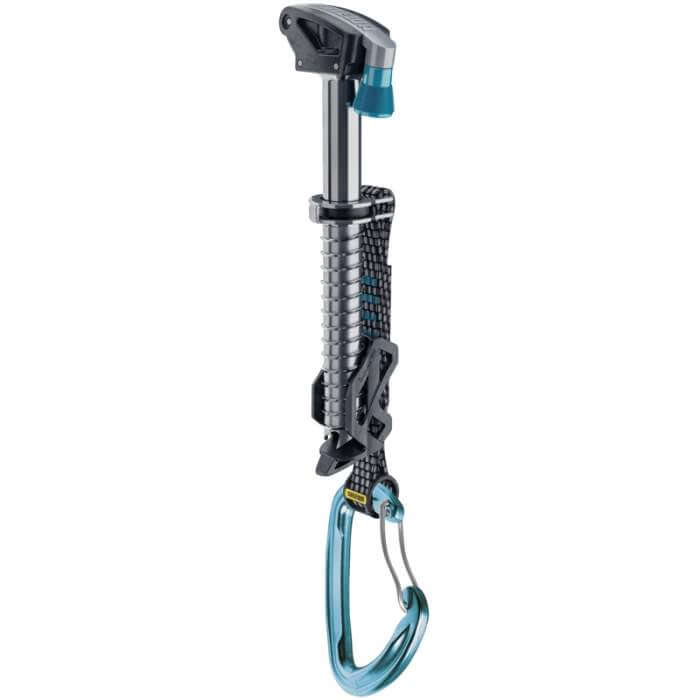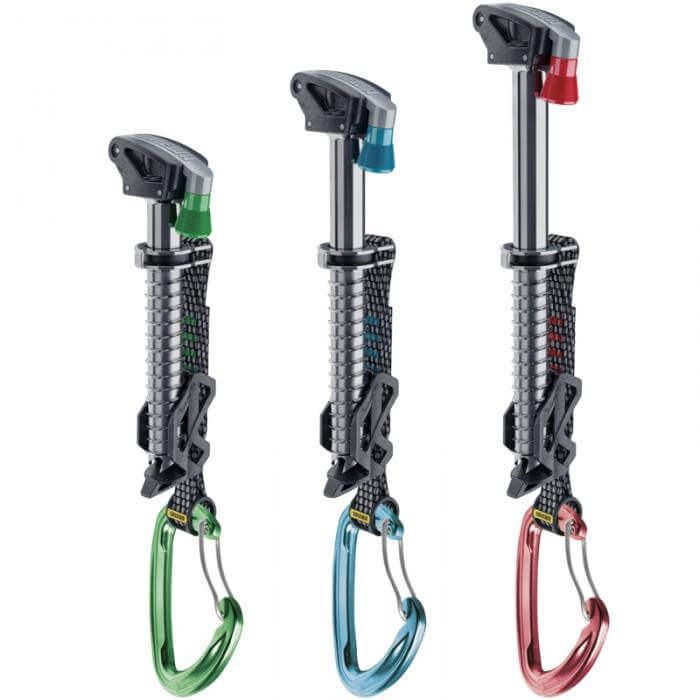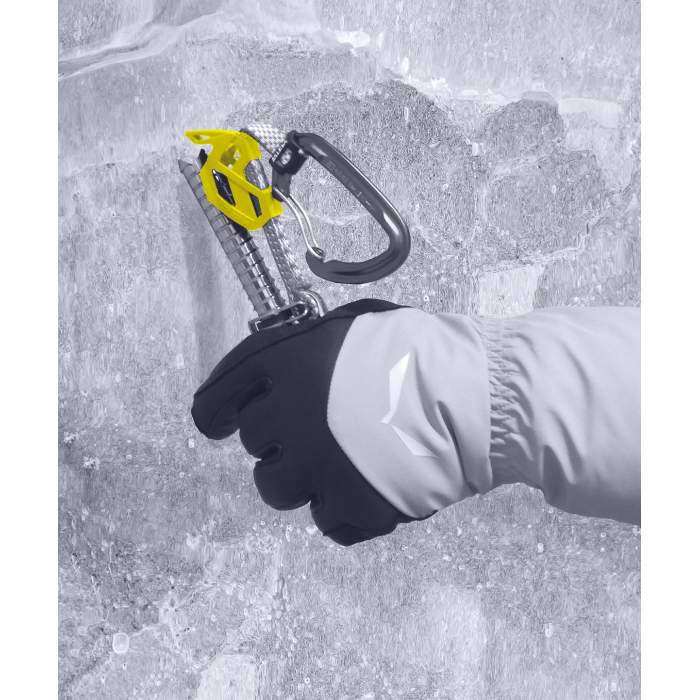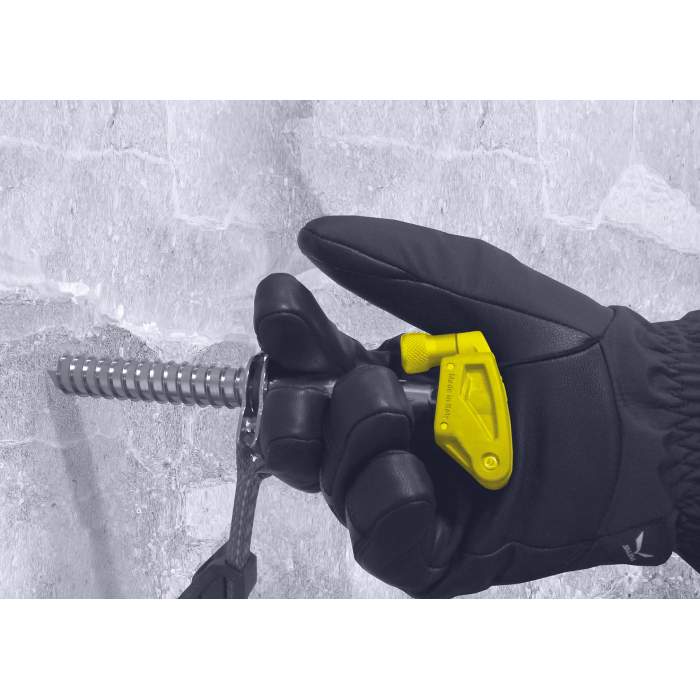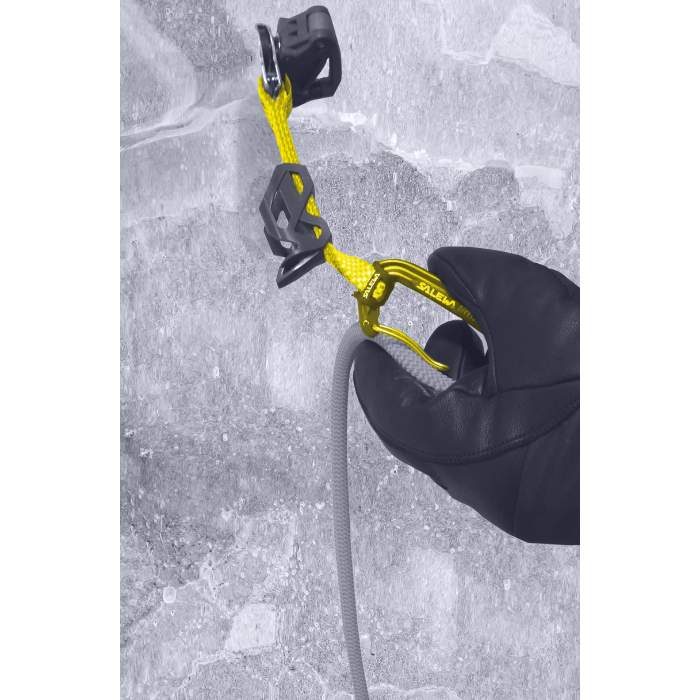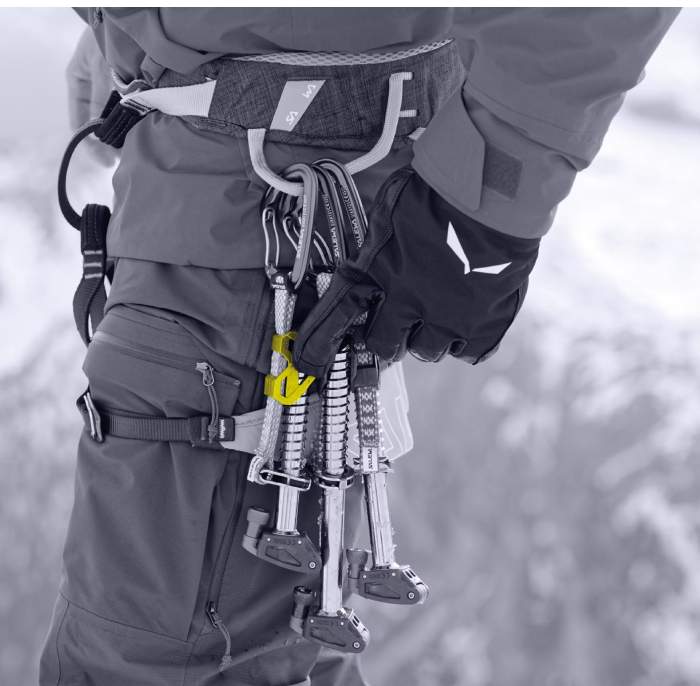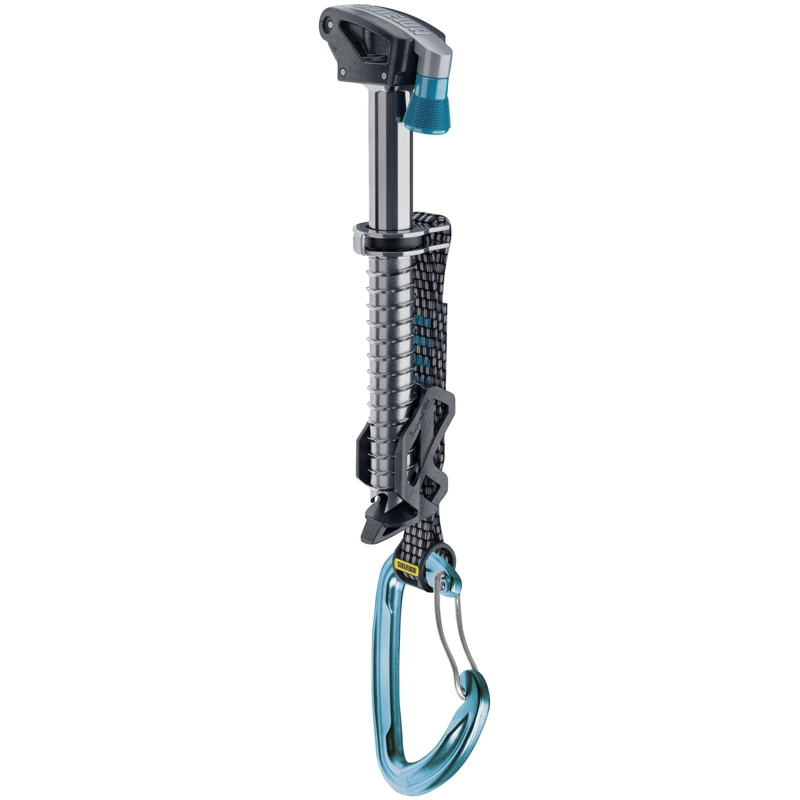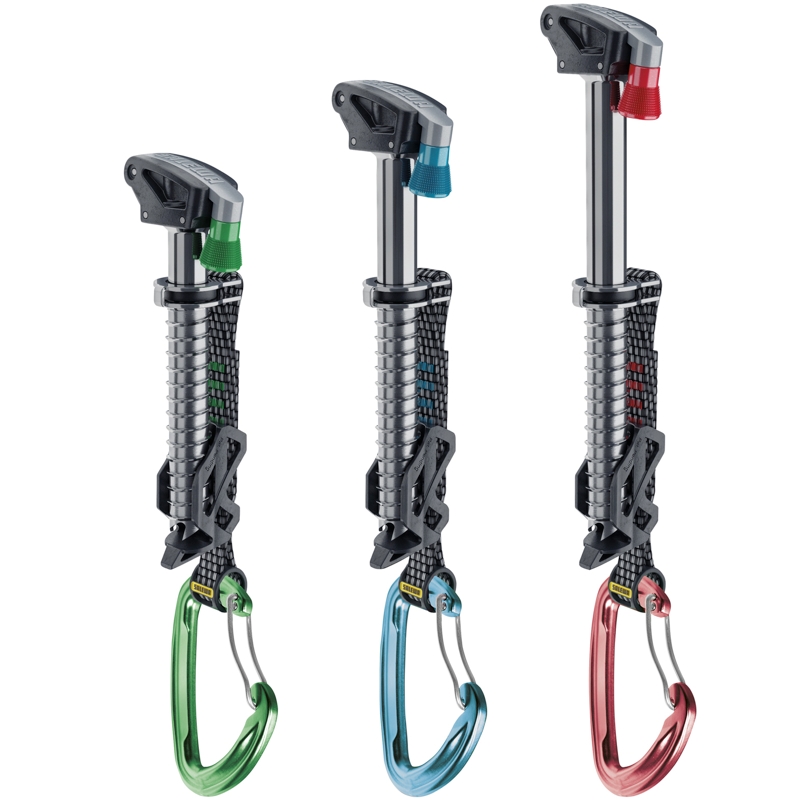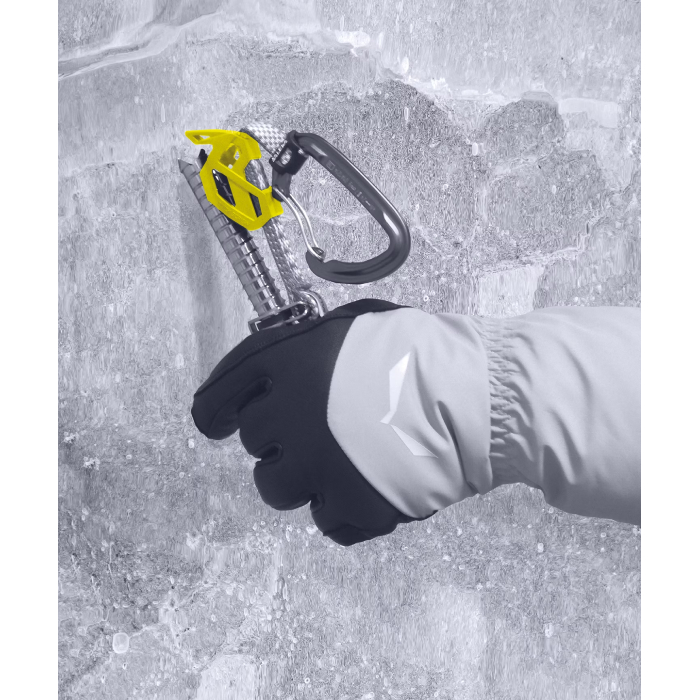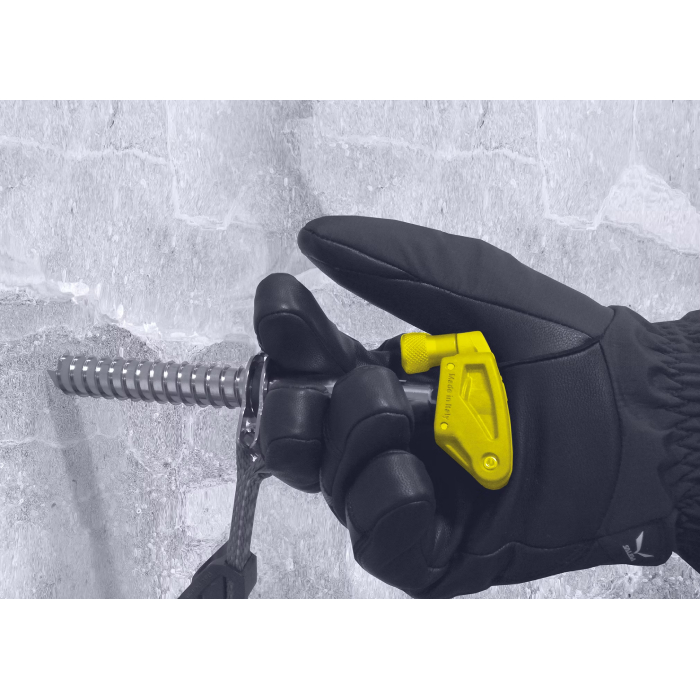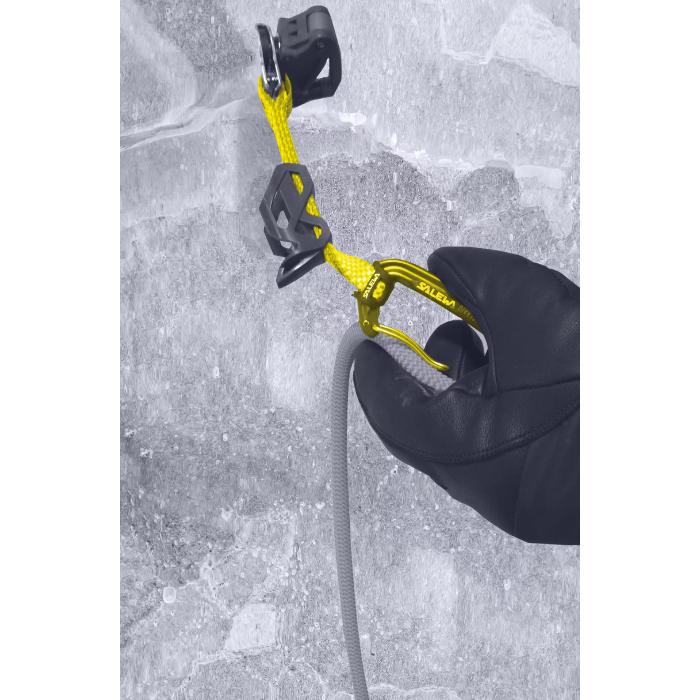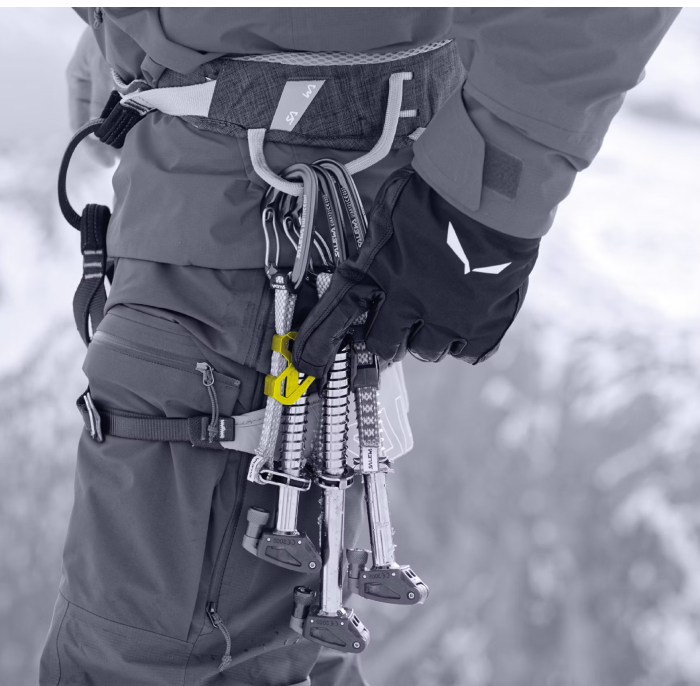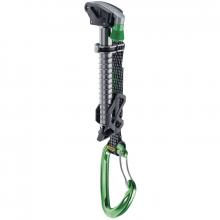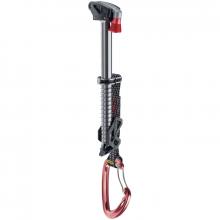A pictoral representation of the UIAA-151 and EN-568 standards for ice screws.
Quick Screw 16cm
Description
Tested and approved by SALEWA athletes. The "quick screw" for ice climbing is so easy to handle thanks to its ergonomically designed head and comes with a fixed screw cap, easily removed with one hand. This innovative ice screw sets new standard.
- Ergonomic head means easy handling and efficient placing of the ice screw
- Winder with large handle for fast and effortless tightening
- Ideal screw placing thanks to compact head and direct attachment of harness loop to screw shaft
- Compact construction avoids overloaded climbing harness
- Colour coding for easy length differentiation
- Integrated screw tip protector (patent registration in progress) won't get lost, prevents injury and damage to clothing
- Screw tip protector fixes screw in place until used, easily removed with one hand
- During removal from the ice, screw can remain clipped to rope and won't get lost
- Three lengths available
Retail price
When you click a link below and then checkout online, no matter what you buy (climbing gear or not), we get a small commission that helps us keep this site up-to-date. Thanks!

Weight (grams / ounces)  Weight (g / oz)In grams and ounces, the weight, as stated by the manufacturer / brand. | 195 g / 6.88 oz |
Length (cm)  Length (cm)Ice screws range between 6 - 30 cm. Generally speaking the sizes can be thought of as: Short - 13 cm and belowShort screws (“shorties” or “stubbies”) are for thin ice found on harder ice climbs and/or in crappy conditions. Medium - 14 - 17 cmWith ideal conditions climbers will be able to plug medium-sized screws with no problem. They have a nice weight to length balance. Long - 18 cm and aboveLong screws are most often used as anchors or in crappy ice conditions where they can go deep to find the real ice below. Mountaineers may also prefer long screws as they can gain better purchase in less than ideal ice and have less chance of melting out. How Many To CarryThere is no standard of how many screws to carry of each size. It will vary depending on where you’re climbing, your style of climbing and what level you’re climbing at. Some climbers will get a variety of the sizes, while others might get a majority of medium screws, a few shorties for thin spots and some long screws for anchors and bomber placements. Note: The amount of threading on each screw does not change even when the overall length changes (exception: e-climbs screws). |
16 cm |
Feature(s)  FeaturesNo Handle / KnobAbout 30% of the options 
Pros: Cheaper Cons: No “speed” handle/knob for faster threading Note: This is not currently a feature to filter on (coming soon), but is important to see the difference. Handle (non-fold)About 24% of the options 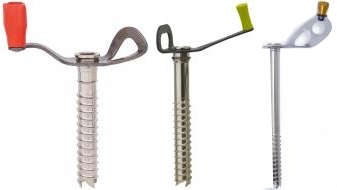
Pros: There is an extra “handle” or “knob” for faster screw threading. Cheaper than folding versions. Cons: Some of the knobs stick out substantially and could cause the rope or draws to get caught on the lengthened handle. Handle (folding)Around 42% of the options 
Pros: Foldable handle allows for quick threading and reduces snagging potential by folding out of the way. Cons: More expensive. Color CodingNearly 70% of the screws are color-coded, and this represents nearly all of the screws that have handles/knobs (color coding can also be on the hanger or the tube itself). 
Pros: Like on cams, color-coding makes for faster size identification. Cons: Generally color coding only comes on more expensive screws (with handles) There are 7 brands that follow red, yellow, blue, gray, green as a small to large standard, but that is not consistent across the industry. Sewn Sling (Pre-Attached to the Hanger)
Pro: You don’t have to carry quickdraws, so it saves weight and speed of clipping. Con: The length of this sling may not be ideal and it is not adjustable 2 Clip Points on the Hanger
Pro: More clipping options, especially ones that are closer to the ice to reduce leverage in a fall situation. Con: This comes standard on only a few screws so your options are limited. On some configurations this will also make the hanger much larger. Reverse Threading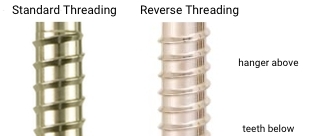
This is the most controversial feature. Grivel and CAMP (which make up 30% of the ice screw market) use reverse threading on all of their screws and claim that this angle is more effective at spreading an impact load across ice. If you are interested in the merits of the “reverse thread” design, click to see photos of the concrete tests (reverse threading pulls out more concrete than standard threading) and read about the concerns of testing in concrete. Read discussion of the engineering that goes into thread design and the questioning of straight pulls while testing to judge if reverse threading would make a [significant] difference in the event of a fall on ice. |
Folding Handle Color Coding Sewn Sling Attached |
Strength (kn)  Strength (kN)In kilonewtons, the strength as stated by the manufacturer / brand. |
|
Materials  MaterialsHangerThe material of the ice screw hanger (what you'd be clipping a carabiner into). Expect Stainless steel or aluminum here. TubeThe material of the tube of the ice screw (aka shaft). Most often it'll be Chromoly or steel but Grivel, Petzl and e-climb (and perhaps others) offer an aluminum tube ice screw option. Nearly 90% of ice screws are made from steel because steel is stronger and more durable. Aluminum screws will dull and wear out much faster and are not designed for crag-style ice climbing. They are specialty ice screws best used for fast and light ascents. TeethThe material of the teeth. Most often the tube material and the teeth material will be the same (e-climb and Petzl are exceptions). Often, screws with aluminum tubes will have steel teeth to help with durability. | Hanger: Steel Tube: Steel Teeth: Steel |
Certification  CertificationsThe main climbing gear certifications are CE and UIAA--and normally the UIAA creates the rules that the CE body also supports. When possible, we try to list all the certifications the product carries. To sell a climbing product in Europe, the device must be CE certified. There are no official requirements to sell climbing gear in the US. The UIAA certification is a voluntary process. Ice screws are not certifiable below 10cm. Learn MoreRock and Ice Certifications Guide |
|
No reviews yet.
The formation of very hard ice – due to the temperatures dropping as low as -17 degrees overnight, sometimes not exceeding -13 degrees in the daylight, meant that for the ice screw to ‘bite’ meant physically having to put a lot of force through the ice screw, requiring more effort to try and get them to attach into the hard ice whilst wearing gloves. In conditions that cold, it’s also not advisable to put gear in your mouth as a means of multi-tasking as this can lead to serious injury , including skin being stuck on frozen metal! Luckily, having a Salewa ice screw, with its sharp teeth and additional functionalities of integral winder, carrier and quick draw made it easy to deploy. It was convenient to deploy as the Salewa Quick screw for when the moves feel awkward, or just for the convenience of having an ice screw that's straightforward to clip to the rope.
I bought 4 of the Salewa screws. I think that’s all I’m going to buy. They are nicely made, and I will probably carry a couple of them on most climbs because they rack so easy with their integral biners and don’t take up space on my caritool. The long size in particular is a great option as I can use it for V-Threads and not have to worry about racking it. However, the fiddly nature of the sequence of placing them one handed means that I’m always going to want to have some more traditional screws with me for steep panic placements.
A good, well polished actual screw with good bite and a handle that is compact and easy to use once you have it in your hand. A major downside for us was the integral quickdraw and the plastic housing system which we found unwieldy, difficult to use and very limiting.
If you like the idea of the racking system and you want a set of screws just for icefall cragging and not for all purpose mountaineering, then these could be worth a look, but try before you buy as the system will certainly take a bit of getting used to.
This video showcases the different features of the quick screws. Short and sweet.

